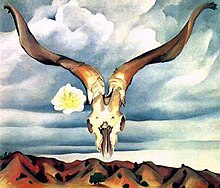Georgia Totto O’Keeffe was an
American artist who mostly painted large flowers presenting them as if seen
through a magnifying lens and was part of the American Modernism Movement. She was
born on November 15, 1887, in a farmhouse near Sun Prairie, Wisconsin as the
second of seven children. At age ten she had already known that she would be an
artist. Her and her sister took classes from Sara Mann, who was a local
watercolorist. O’Keeffe attended the Art
Students League in New York City, where she won a scholarship to attend the League’s
outdoor summer school. She won the scholarship for her oil painting Dead Rabbit with Copper Pot.

In 1908 O’Keeffe was working as a
commercial artist in Chicago after relinquishing her career as an artist. Four years
later she was introduced to the ideas of Arthur Wesley Dow in the University of
Virginia, where she was motivated to paint again. At this time women didn’t
have access to art training in America’s colleges and universities. Yet this is
where she learned about expressing herself through her paintings. Dow believed
that someone could use line, color, and shading harmoniously to express
themselves. From 1916 to 1918 O’Keeffe used
the Palo Duro Canyon as a subject in her works while teaching in West Texas
A&M University in Canyon.

Georgia O’Keeffe found her own
style of painting around the mid-1920s. She added repetitive colors, forms, and
themes in her works during the 1930s. “She liked to stress visual edges that
have metaphysical implications: between night and day, earth and sky, life and
death. She was not afraid of the large, symbolic reverberation; her bones often
seem strangely alive, the flowers of the desert” (Georgia). She usually painted
flowers and bones which let her violate certain boundaries.
Some of her most famous paintings
are: Cow’s Skull: Red, White, and Blue and Cow’s Skull with Calico Roses.
O’Keeffe began painting bones because of the majestic landscape of New Mexico.
The desert bones helped her imagination but what brought everything together
was scenery that was before her. “With its unusual geological formations, vivid
colors, clarity of light, and exotic vegetation, that held her attention for
more than four decades. Often she painted the rocks, cliffs, and mountains in
dramatic close-up, just as she had done with her flower subjects” (O’Keeffe).

She showed a different side of art by
painting natural beauty. “It was through these drawings that O'Keeffe came to
the attention of the prominent photographer-turned-New York gallery owner
Alfred Stieglitz in January 1916. After supposedly exclaiming, "At last, a
woman on paper!" he exhibited her drawings at the 291 gallery, where the
works of many avant-garde European and American artists and photographers were introduced to the American public” (O’Keeffe).
What O’Keeffe did revolutionized
modern art in both her time and now. http://www.georgiaokeeffe.net/
Works cited
Chadwick, Whitney. Women, Art, and
Society. New York, NY: Thames and Hudson, 1990. Print.
"Georgia O'Keeffe
Biography." Georgia O'Keeffe Biography. N.p., n.d. Web. 19 Nov.
2012. <http://www.lkwdpl.org/wihohio/okee-geo.htm>.
"Georgia O'Keeffe." Gegorgia
O'Keeffe Paintings, Biography, and Quotes. N.p., n.d. Web. 19 Nov. 2012.
<http://www.georgiaokeeffe.net/>.
"Heilbrunn Timeline of Art
History." Georgia O'Keeffe (1887–1986).
N.p., n.d. Web. 19 Nov. 2012.
<http://www.metmuseum.org/toah/hd/geok/hd_geok.htm>.
The Guerrilla Girls' Bedside Companion to the History of
Western Art. New York: Penguin, 1998. Print.
No comments:
Post a Comment